Are Terra Cotta Pots Aquarium-Safe? What You Need To Know
When you purchase through links on our site, we may earn a commission. Here’s how it works.
Could a $2 garden pot save your fish, or accidentally kill them?
Believe it or not, the humble terra cotta pot isn’t just for your backyard. When used correctly, it can be a powerful tool in your aquarium, creating plant holders, hiding spots, breeding caves, and even food stations. But here’s the catch: some pots are dangerously toxic to fish.
In this guide, you’ll discover how to choose aquarium-safe terra cotta pots, how to prep them properly, and the smart ways to turn them into beautiful, functional aquarium features. Whether you’re setting up a planted tank or designing a breeding zone, you’ll find a terra cotta trick that works for you.
Table of Contents
Are Terra Cotta Pots Safe for Aquariums?
Terra cotta is a type of natural clay that is fired in a kiln, making it both durable and porous. These properties make it ideal for underwater use, provided no harmful coatings or residues are present. But how do they affect fish?

Glazed or painted pots may contain toxic substances such as lead or copper that can leach into your tank and harm aquatic life. Likewise, pots that have been previously used in gardens may carry traces of pesticides, herbicides, or fertilizers that can contaminate water and disrupt your aquarium’s ecosystem.
5 Point Safety Checklist for Aquarium-Safe Terra Cotta Pots
- Unglazed, unpainted, dye-free clay only
- Natural reddish-orange color (typical of kiln-fired clay)
- Brand new — never used in soil or outdoor environments
- No adhesives, stickers, or sharp edges
- Cleaned with hot water only — no soap or detergent
How to Choose Aquarium-Safe Terra Cotta Pots (& Our Reco’s)
Before dropping any old clay pot into your tank, it’s essential to understand which types are actually safe for aquarium use. While terra cotta is generally fish-friendly, not all pots are created equal.
Glazed, painted, or reused garden pots can introduce harmful substances into your water. The following tips will help you select the ideal type of pot to maintain a clean aquatic environment and keep your fish healthy.
| Terra | 6 -Inch Pot | Small Cave Hideout |
|---|---|---|
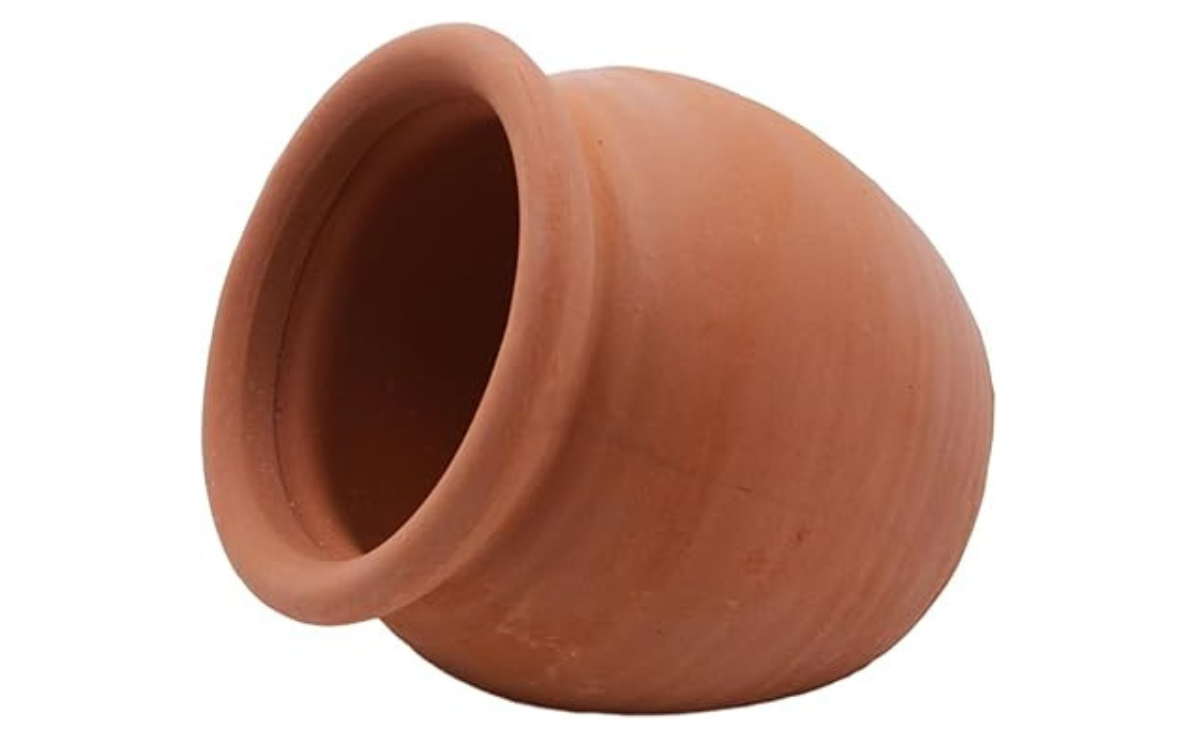 | 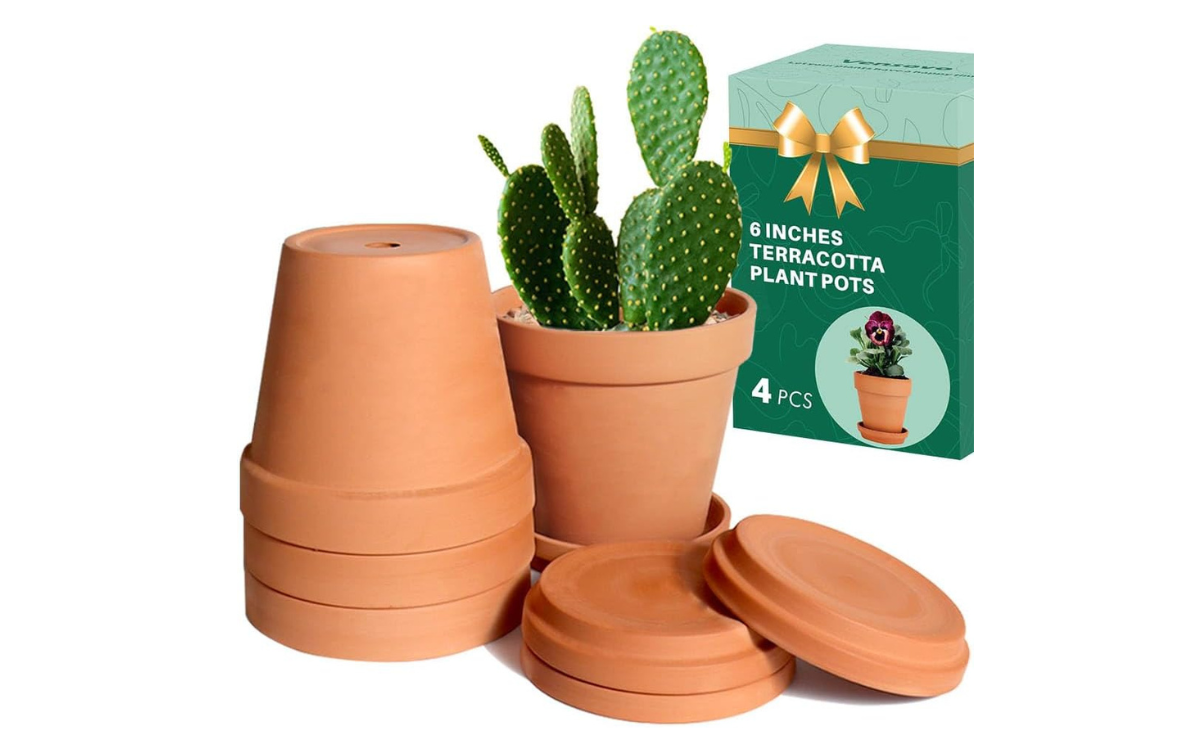 | 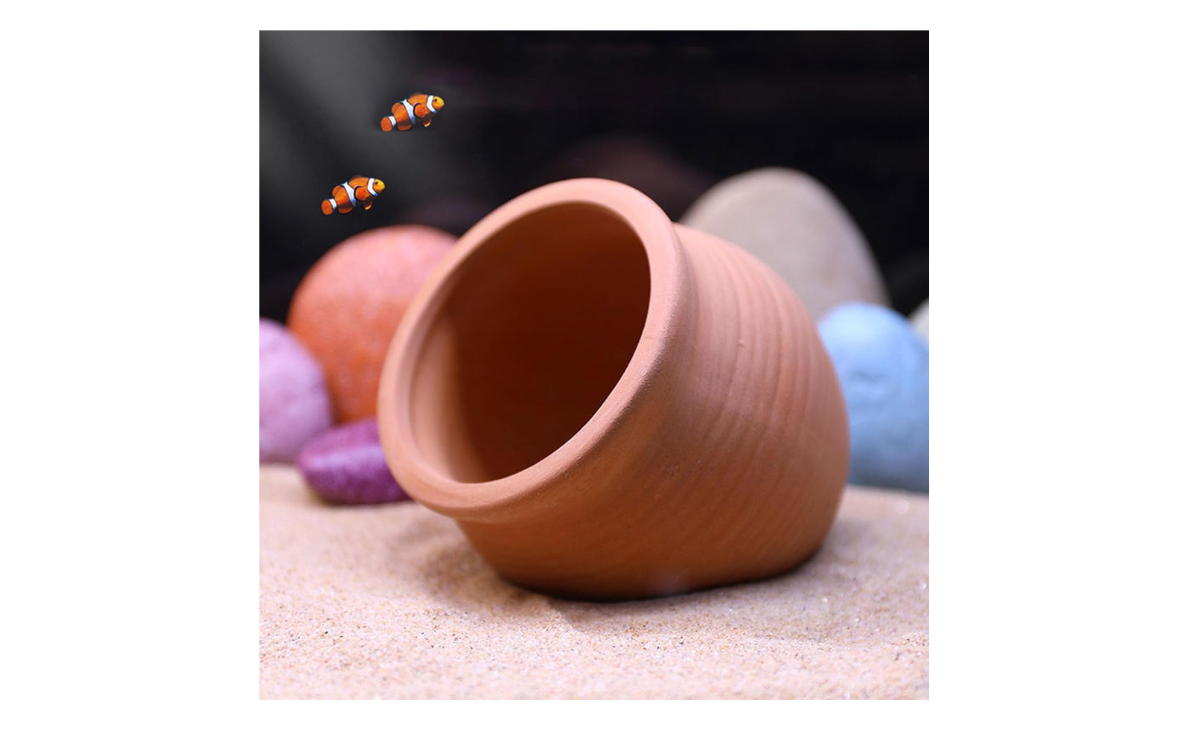 |
| Saim Clay Pot Hideout | Vensovo 6 Inch Terracotta & Clay Pots | PENCK Betta Hide Ceramic Jar |
| View on Amazon | View on Amazon | View on Amazon |
What Makes a Pot Terra Cotta
Terra cotta is a reddish-brown clay that has been fired in a kiln. The firing process gives the pot strength and its distinctive color. These pots are porous, breathable, and commonly used for gardening, but they are also ideal for aquariums when left untreated.
The matte surface and natural texture allow for better algae control, easy integration into aquascapes, and even minor water circulation through the clay.
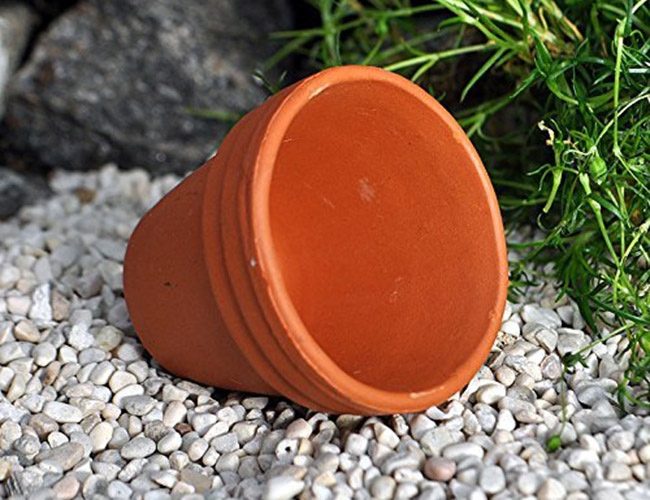
What To Avoid
- Glazed pots — glazes often contain chemicals or heavy metals that are unsafe for fish
- Painted or dyed pots — pigments may leach into your aquarium and cause water quality issues
- Used garden pots — may retain chemicals from fertilizers, pesticides, or mold
If the pot has a shiny surface or any sign of coating, skip it. Stick to basic, uncoated terra cotta designed for planting.
Where to Buy Safe Pots
- Local nurseries or garden centers often sell unglazed terra cotta in a variety of sizes
- Hardware stores — check the garden or outdoor section for plain clay pots
- Online marketplaces — choose pots labeled “unglazed,” “natural clay,” or “food-safe”
- Aquarium specialty retailers — offer pre-cleaned, fish-safe clay shelters for specific species
Always double-check the product description or ask a staff member if you’re unsure about the pot’s treatment or finish.
Not all clay is created equal. Kiln-fired terra cotta is stable, inert, and safe for long-term underwater use, while air-dried or sun-dried clay can soften, break down, or leach minerals over time. The key difference lies in the firing process; kiln firing vitrifies the clay, locking its structure and making it suitable for aquarium environments. If you’re unsure about the type of clay used in your pot, it’s safest to stick with commercially fired terra cotta designed for gardening.
Real-Life Example: Terra Cotta Pot Cave in Action
Here’s a quick look at how terra cotta pots work in a real aquarium setup. In this video, a simple, unglazed clay pot is used as a DIY cave for bottom-dwelling fish, providing both shelter and a natural look that blends seamlessly into the tank. It’s a great example of how effective this budget-friendly solution can be when done right.
How to Prepare Terra Cotta Pots for Aquarium Use
Once you’ve chosen a safe, untreated terra cotta pot, preparation is key to making it fish-friendly. A few simple steps will ensure your pot is clean, smooth, and free of hazards that could harm your tank or its inhabitants.
Remove All Labels and Adhesives
Start by peeling off any price stickers, barcode labels, or leftover glue. If residue remains, lightly sand it off; avoid using chemical cleaners, which can be absorbed into the porous clay.
Smooth Sharp Edges
Run your fingers around the rim and any broken edges. If you feel anything jagged, sand it down with fine-grit sandpaper to prevent your fish from catching their fins or scales.
Customize Your Pot
You can break or cut the pot to create caves, tunnels, or openings. A hammer will give you organic, irregular shapes. For more precise cuts, use a Dremel tool with a diamond cutting wheel. Don’t worry if the interior looks gray; that’s normal and still safe.
Handle Drainage Holes Safely
If your pot has a drainage hole, either plug it with aquarium-safe glue or silicone or remove the bottom entirely. You can also use rocks to block the hole if you have the right-sized stone. Fish can get stuck trying to swim through these openings, a common and preventable accident.
Rinse Thoroughly (But Skip the Soap)
Use hot water to rinse away dust or debris. Never use soap or detergent because terra cotta absorbs chemicals easily, which can later leach into your tank and harm your fish.
Expect Bubbling in the Tank
When you first place the pot underwater, you may notice air bubbles escaping from the surface. This is normal and completely harmless, as it is simply the air trapped in the clay’s pores being released.
For a deeper dive into porous materials that benefit your tank, learn more about how ceramic rings support your filter system.
Understanding the Color of Terra Cotta
Most terra cotta pots have a natural reddish-orange or burnt sienna color. This signature tone comes from iron-rich clay that turns red when fired in a kiln, a key sign that the pot has been properly hardened for safe underwater use.
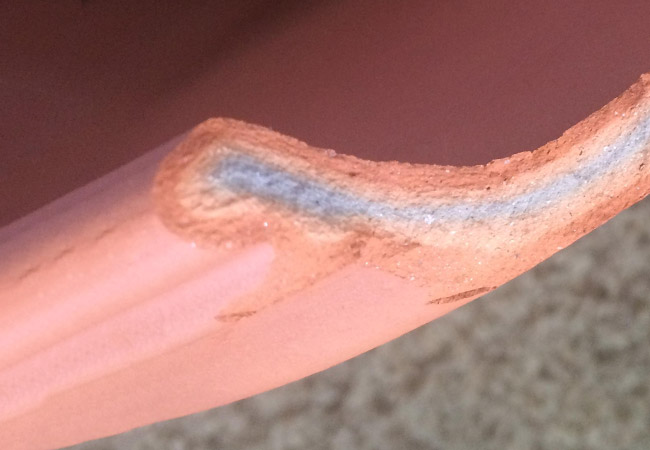
Sometimes, when a terra cotta pot is cut or broken, the inside may appear gray or lighter than the outside. This is normal and not a sign of dye or chemical treatment. The inner layers simply received less direct heat during firing and retained more of the clay’s original color.
As long as the pot is unglazed and untreated, even gray or color-varied sections are perfectly safe for aquarium use.
If you are not feeling brown, you could always use an aquarium-safe paint to brighten up your terra cotta pots.
How to Use Terra Cotta Pots for Aquarium Plants
Using terra cotta pots in a planted tank gives you flexibility and control. Instead of planting directly in the substrate, place rooted plants inside clay pots filled with gravel or aquarium soil.

Benefits of Planting in Pots
- Makes rearranging plants easy; just move the pot
- Ideal for bare-bottom tanks where substrate isn’t used
- Helps contain root growth and reduce substrate disruption
- Enables you to dose root tabs or fertilizers more precisely
Good candidates include Amazon swords, Anubias, Java fern, and other rooted species. Just be sure the pot is big enough for root development and properly anchored so it doesn’t tip over.
Creating Fish Caves and Shelters with Terra Cotta Pots
Fish love secure hiding places, and terra cotta pots are a simple, affordable way to create them. Depending on the size and orientation, a pot can become a cave, tunnel, or covered alcove inside your aquarium.
- Shy or nocturnal fish benefit from dark, enclosed shelters
- Plecos, cichlids, and loaches often use pots for territory or rest
- You can bury the pot halfway in substrate or lean it against driftwood for a natural look
Customize your pot by breaking off a portion or cutting an entrance. Just be sure to smooth the edges and select a pot size appropriate for your fish… too small, and it becomes unusable; too large, and your fish may ignore it.
If you break out the bottom, you can even use a clay pot as a tunnel for your fish.
Just make sure you choose the right-sized pot for your fish. If your fish is too big for the cave or tunnel, your clay pot is just going to become an unused aquarium decoration.
Using Terra Cotta Pots as Fish Breeding Caves
Breeding fish often need quiet, enclosed areas to feel safe when laying eggs. Terra cotta pots mimic natural caves and can help encourage spawning behavior in species like cichlids, clownfish, and bristlenose plecos.

- Choose a pot that’s large enough for adult fish to enter and turn around
- Place the pot on its side or slightly angled for better access
- Ensure the pot is stable and won’t roll or tip
- Position in a low-traffic area of the tank to reduce stress
You can use a whole pot or cut an entryway to create a more cave-like design. For convenience, pre-made terra cotta breeding caves are also available and offer similar benefits with less prep work.
How to Use Terra Cotta Pots as Aquarium Feeding Stations
Terra cotta pots can double as feeding stations in your aquarium, especially for fish that eat sinking pellets or wafers. By keeping food in one place, you minimize waste and make cleanup easier.
- Ideal for bottom dwellers like plecos, shrimp, and crayfish
- Prevents food from scattering across the tank
- Reduces water quality issues from uneaten food
- Gives shy or nocturnal fish a covered area to eat
Place a small clay pot on its side or upright in your preferred feeding area. After feeding, you can remove the pot to rinse out any leftover food. This method is simple, reusable, and effective for maintaining clean tanks.
Aquascaping with Terra Cotta Pots: Creative Decoration Ideas
Beyond function, terra cotta pots can enhance the look of your aquarium. Their natural, earthy color blends well with plants, rocks, and driftwood, and with a little creativity, they become beautiful focal points or thematic features.
Decoration Ideas with Clay Pots
- Group pots together to create a tunnel system or “pot city”
- Partially bury pots in substrate for a natural, sunken look
- Combine pots with moss, Anubias, or ferns growing from the rim
- Use broken or cut pots as ruins or scattered artifacts
Because terra cotta is porous and neutral-colored, it doesn’t distract from your aquascape; it enhances it. You can create everything from rustic jungle themes to structured rock gardens using just a few inexpensive pots and plants.
Just be careful not to overdo it. Too many pots can clutter the tank and limit swimming space, so aim for a balance between decor, plants, and open water.

By positioning terra cotta around your tank, you can create an environment that your fish will love!
Caring for Terra Cotta Pots in Your Aquarium: Maintenance & Longevity Tips
While terra cotta pots are safe and durable for aquarium use, they still require occasional inspection and care. Over time, clay pots can accumulate biofilm, develop cracks, or discolor. Regular maintenance ensures your setup stays clean, safe, and visually appealing.
What to Watch For
- Cracking: Remove and replace any pot with sharp breaks or structural damage.
- Biofilm buildup: Gently scrub the surface with a toothbrush in old tank water. Avoid harsh chemicals.
- Discoloration: Orange-to-brown staining is normal. Green or black buildup may indicate algae or mold and should be cleaned.
When to Replace a Pot
- Visible chips or cracks that could harm fish
- Persistent foul odor, even after rinsing
- Softening or surface crumbling (rare, but possible in poor-quality clay)
In most cases, a quality terra cotta pot can last for years underwater with only basic upkeep.
Common Mistakes with Terra Cotta Pots in Aquariums (and How to Fix Them)
Terra cotta pots are safe and versatile, but only when used correctly. Avoid these common mistakes that can put your fish or tank at risk.
Using Glazed or Painted Pots
Even clear glazes or decorative coatings may contain harmful chemicals that leach into the water. Always choose unglazed, untreated terra cotta only. If you’re unsure, skip it. Leach‑test data show that even untreated clay can leach trace metals when flawed, another reason for careful pot selection.
Leaving the Drainage Hole Open
Fish often try to swim through the small hole at the bottom of the pot, and can get stuck or injured as a result. Always plug the hole with aquarium-safe silicone or remove the bottom entirely.
Sudden Water Discoloration
If your tank water becomes yellowish or rusty, it may be due to poor-quality clay or mineral reactions. Remove the pot and monitor water quality. Try boiling the pot before use to release excess trapped materials.
Using the right materials in your tank is just one part of responsible fishkeeping. See more essential tips in FishLab’s guide to things fishkeepers should never do.

Healthy Tank, Happy Fish
Once your terra cotta pots are safely placed, you’ve done more than decorate; you’ve enhanced your tank’s structure, created hiding spots, and supported a healthier environment. But thriving aquariums rely on more than good décor. Choosing beginner-friendly plants, like those in this guide, can help stabilize water conditions, while expert aquascaping tips take your layout to the next level.
Terra cotta and other natural materials can sometimes cause short-term water cloudiness or color shifts. If that happens, these simple hacks will help you keep things clear. For more specific troubleshooting, see FishLab’s guides to cloudy water or green algae blooms. Most of these issues are temporary and easy to manage with the right approach.
Finally, no setup is complete without proper nutrition. This fish nutrition guide outlines exactly what different species need to stay healthy. Combine good food with clean water, thoughtful layouts, and simple materials like terra cotta, and you’ll have a tank that’s not just beautiful, it’s balanced. A healthy tank supports happy fish, and happy fish make this hobby truly rewarding.
What’s Your Experience with Terra Cotta in Aquariums?
Have you created a clay pot cave that your fish love? Built a breeding zone that worked perfectly? Or maybe learned a hard lesson about a drainage hole the wrong way? We want to hear it.
Share your experience in the comments below, whether it’s a quick tip, a setup photo, or a question for other hobbyists. Your story could help someone else build a better, safer, and more beautiful aquarium. Let’s build a community of fishkeepers who learn from each other, one terra cotta pot at a time.
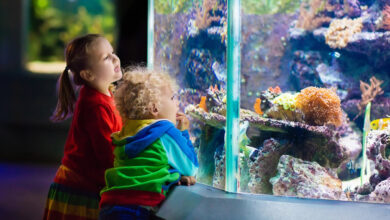
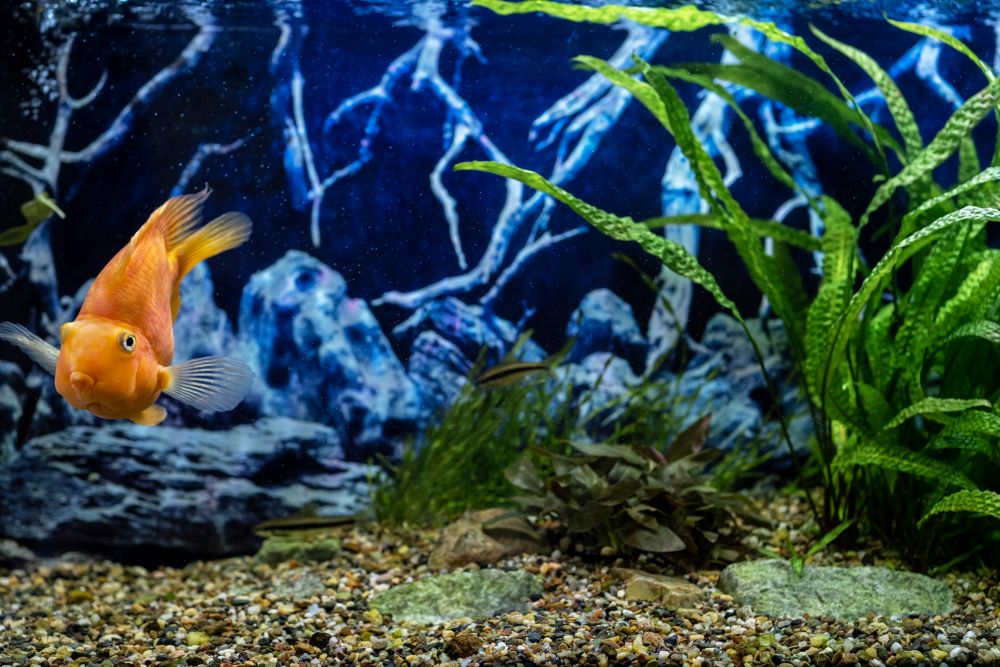


I can’t wait to start designing my
100 gallon Discus tank with live plant’s with terra cotta pots they look so beautiful
My question is can you only use the unpainted ones
Hi Tina,
Great question. When it comes to terracotta pots, avoid anything that has been painted, dyed or glazed. The problem with painted terra cotta pots is that they can leach harmful chemicals into your aquarium. If you stick to the plain orange pots, your Discus will thank you for it!
What kind of setup would you suggest for a 10 gallon tank? I really like the look of the terracotta pots and they are inexpensive.
Most terracotta pots after weeks underwater become soggy, brittle and breakup on touch.
Hi Santhosh,
Interesting observation. Are you sure the pots you are using in your aquarium terra cotta? I only ask because terra cotta is commonly used in aquarium products like pleco caves and cichlid breeding huts.
Air dried clay pots on the other hand will quickly reabsorb water, turning back into soft clay when placed into your aquarium.
Kiln fired clay pots (terra cotta) are typically considered aquarium safe by hobbyists. As always, fishkeeping is an ever evolving hobby and if you can provide evidence to the contrary then I would love to know more!
Thanks for your comment!
I just bought some water plants with the idea of making a very small water garden – no fish just plants. I’m frustrated trying to find a way to put the plastic pots back in the water without a lot of soil leaking out. How does this sound like it would work??… plug up bottom drainage hole of a terra cotta pot just by laying a piece of coffee filter or thin foam air filter type of material, and then go ahead, repot, and then submerge the whole deal in the water up to the appropriate level for the plant?
Hi Kate,
Unfortunately, I am unfamiliar with water gardens. However, in an aquarium you would just seal these holes up with silicone. Since these holes are just for drainage, and the whole pot is submerged, they don’t really serve a purpose.
Now you also want to stop the water from floating out the top. In aquariums, a capping is added. A capping simply refers to using another material to seal the soil in (in aquariums 2-3 inches of soil is typically used). Most aquariums use either a thick layer of gravel or sand to cap the soil. This way your plants are getting the nutrients they need without the soil leaching into the water.
I Hope this helped!
Hi There,
I purchased a clay pot from the fish store and after 2-3 months of it being in the freshwater tank, i noticed the top half is slowly staining (like mold on a wall). Is that a good thing or bad thing? I don’t have any real plants in the tank so I don’t think it’s algae since the rest of the tank is pretty clean.
I do a partial water change every week cause it’s a smaller tank.
Hi Jessica,
Great question! This slow staining could be anything – bacteria, biofilm, algae etc. If you have used an aquarium test kit, and your water parameters seem normal, then it’s probably nothing to worry about. Pots just get “dirty” over time. If you scroll through some of the pictures you’ll see that some of the terracotta pots from more established tanks have light brown or green discolorations. If it really bothers you, you could try cleaning your pot in a mild ammonia solution before rinsing it with freshwater. However, it’s highly likely that this discoloration will still come back.
I have cichlids and they move the sand a lot should I glue the pots together if so what’s safe to use
Hi Kammie,
If your pots are not stable, you can certainly glue them together. If you do go down this route, check out our guide on aquarium safe glue.
Thank you so much for you straight forward information. After 18 years I am redesigning/refurnishing my koi pond, have a gutter downspout in the correct location and want to have the gutter empty into the pond. Research has ruled out the possibility of any kind of metal rain chain, but your site has given me the idea of creating one out of vynal and clay pots. Should work wonderfully and I’m very exited about being able to include this feature in my pond set up. Again thanks so much.
Hi Jeana,
That sounds like a very creative use of clay pots. I would love to see a photo of it when you are done!
Thank you for the overview! It was tough looking for a comprehensive one online. Question: what suggestions do you have for making a hole in one? (Using it upside down with a hole to make a cave). A lot of people suggested using tile cutters or filers, but wanted your opinion also
Hi Judy,
I assume you mean creating a hole in the side of the pot? As long as it’s a thin walled terracotta pot, a dremel with a diamond cutting disk is more than up to the task. Best of all, it’s something you will likely find a use for in the future, unlike a tile cutter. Don’t forget to file down all edges, so that there are no sharp pieces left – you don’t want your fish catching their fins!
I like the ideal if using the clay pits in the fish tank . I want to know what do you use to file down the clay pots after you break them and what can you break them with. I would live to see examples of you doing this
Hi BE,
Great questions. Next time I do a terra cotta aquascape, I’ll add some pictures to this guide. I usually either use a hammer if I want random broken bits or a dremel with a diamond cutting wheel if I want something more control over the shape. To smooth those edges, either a dremel sanding tool or some old fashioned sand paper will do the trick.
I have two aquariums a 20gal. and 50gal, in the 50gal I have two terra cotta pots for my Blood Parrot Fish, I am having trouble with the PH being to low at 6, do you think these pots could be the cause? I love all your ideas. Thanks
Hi Susan,
I’d be surprised if the pots were the cause of your low pH. The first thing you should do is test your tap water pH and KH before adding it to your aquarium, to determine that it is actually something in your tank responsible for the low pH and not the tap water itself.
Hi, I put in a small terracotta pot in my aquarium, I have black sand in my aquarium, the next morning I noticed some rust colored stuff on some of my sand, I guess it’s the same color of the terracotta pot. Is this normal? For some of the pot to come off and be on the substrate? I did rinse it before hand.
Hi Roxanne,
Depending on the quality of the terra cotta pot, it is possible. Normally this doesn’t happen until the terra cotta pot has been submerged for quite some time. I’m surprised you have seen it happen after just a single day, especially after a good rinse. If it continues to break down, I would remove it from your aquarium.
We have just put Terracotta pots in our aquarium and now the water is a yellow colour. There is nothing else in the aquarium that would have caused that and we are wondering if it will be harmful to the fish?
Hi Tamara,
Do you have driftwood or any other pieces of wood or dried plant matter in your tank? If yes, then you should know that these release tannins, which yellows up the water. Tannins are natural and often beneficial, especially if they are found in your fishes natural habitat. Many people add indian almond leaves to their betta tanks for their tannins.
If it’s your pots, then that’s not expected and is cause for concern. I have never experienced terracotta pots turning water yellow. Many discus owners use terracotta pots in bare bottomed tanks, with little else in them, and their water remains crystal clear.
I have a 200gallon Aquarium with Male and Female Red Devils. I also added ten large pots and my water went from super crystal clear to a yellowish tinted color. I have used these pots before and never this outcome. I think because of the quantity of pots the pots leached and turned the water. I removed the pots and 80% water change and now I’m back to super crystal clear water. My conclusion is keep the pots to a minimum and you’ll be fine without yellowing. I do miss the pots and now I’m hunting for a cave solution. I may have to use boulder and glue them together for stability. Hope this helped in someway
Pascal.
I read the aquarium pots with plants should have an opening on the bottom to help the roots. You advise sealing the bottom hole with aquarium silicon. Your thoughts, please.
Hi Will,
As per the article, this advice is for using pots as caves, so fish don’t get stuck. If you place a pot in a normal orientation, and fill it with soil, a fish can’t swim through the drainage hole.
Hi
I have seen some “chocolate terracotta pots”. Do you have any experience with these. I can’t see why they would be a problem as they are not painted. I’m guessing the colour is something to do with the type of clay used or the firing process. I have seen cichlids hides that are dark grey/white so assume that different coloured clay would be ok to use?
Hi Rob,
As a lot of pots are manufactured over seas, where regulations and materials are different, I cannot comment on the safety of a particular type of pot.If you have noticed no adverse reactions and your water parameters are normal then that all sounds positive.
Is there anything aquarium safe that the pots can be covered in so not looking at the ugly red color. I have a bunch of small pots in with my juvenile African cichlids, but will be needing bigger pots soon. Their versatility is unmatched, I just hate the unnatural look.
Hi Joshua,
You could paint them then coat them in a clear 2 part epoxy. However, this process is quite time consuming, fiddly, and you need to make sure they are completely sealed, otherwise you risk paint leaching into your aquarium. Otherwise, you could try hiding them by using plants and decorations?
Would it be a problem if you boiled the pots before hand d to make sure bacteria gone
Hi Zach,
I don’t think this is an issue at all. I have personally brought terra cotta pots to a slow-boil in the past for this very reason, I was concerned they were contaminated.
I am in the middle of setting up my very first aquarium. Today I have added the plants. The customer advise give to me, was to just leave these plants in the plastic pots. As you probably can imagine it looks rather bad. For ideas I reached out to the www and come across your little tips how to incoporate terracotta pots. Such a cute idea but my aquariums decor is grey, white and dark grey and the orange terracotta colour would just clash. I have found some very cute grey coloured pots but am worried that they are chemically treated eventhough they look very natural. Is there anyway of knowing?
Hi Helena,
Unfortunately, there is no easy way of knowing what is in the pots for sure, they are usually manufactured overseas where quality control can be hit and miss. I live by the motto: When in doubt don’t add it to your tank.
I’m new to fishcare. I rescued a betta from a tiny cup and now he’s my pretty boy. I originally had him in a 1 gallon Mason Jar and when I first put him in it he flipped out! He was so happy. But I wasn’t happy with the small tank and bought a 3 gallon acrylic tank with filter and LED light. I let him adjust then I added a moss ball. He pushes it back and forth in the tank. This little guy is amazing. I never imagined that he would interact with me the way he does. I named him Samari Jack and I talk to him through out the day.
I want him to be happy and I have been searching for a tank ornament that is also a hideaway. I haven’t been happy with anything I have found in the store and I am so glad to find out that Terra Cotta pots are safe. I already have the perfect thing. My tank is round and a lot of stuff doesn’t fit in the circumference. Thanks for your help!
Hi Rebecca,
Firstly, well done for upgrading your bettas home. A 1 gallon mason jar is indeed too small for a betta. In order for them to really shine and share their personality with you, they need a larger tank. Samurai Jack is an awesome name – my nephew loved that show when he was younger. You are correct in that square tanks are much easier to decorate than round ones, I’m glad to hear you have found a solution with terracotta pots!
I just had a head smack moment when I was scrubbing all the rocks (AGAIN) because of a horrific algae problem – that started about a year ago. I’m not fancy – my pond is a good sized, black Big Box pond liner. I keep gold fish and guppies, it makes me happy to feed and check on them. I have had it for years, like more than a dozen. Filtration is a sponge type filter on a “fountain” that I clean regularly. About a year ago I started have insane algae problems. I tried everything I have read about (manaul labor, water changes and algaecides, liquid and block) and my tough old fish have survived – but so has the algae. Several times and again today, I have removed all the rocks I have in there as ornaments – they are just rocks (ping pong to softball sized) I have brought home from when we travel (we live in Florida – we don’t have rocks!) and soaked and scrubbed them clean again… when it dawned on me – the only thing I have done differently was about a year ago – I sunk a Terra cotta/ceramic urn/pot in there for the guppies to hide in. It is glazed cobalt blue on the top but unfinished inside and on the bottom, it’s designed to sit with the opening at about 45 degrees. It’s very pretty – but as I was scrubbing it clean yet again tonight – it hit me, COULD THAT BE WHAT STARTED MY ALGAE PROBLEM??
Hi Kristin,
You sound like a very dedicated fishkeeper, I have to applaud it.
It’s almost impossible to determine whether or not the pot was the cause as without a chemical analysis, we can’t determine what, if anything is leeching out of it. Have you tested the various levels of nutrients, including how often light hits your pond? This is often the cause of algae, as it has something to “feed” off.
Hi. 🙂
Have been using clay pots and pieces for years.
A natural way to “hide” them is to use cotton string or fishing line to tie on moss , pieces of moss ball, and or java fern, anubis, or bolbitis ( this one likes water movement, put it near the filters outflow).
Most people say that the plants/ moss attached itself before the cotton string dissolves, but I have experienced otherwise, so I prefer to use fishing line. Once the moss grows you will not see the string anymore anyway.
🙂
Hi Kay,
That’s a really cool way of making pots blend in to the tank. I personally don’t mind the contrast of the brown pots in a planted tank, but this is a great tip for people who don’t like the aesthetic. Especially those who are considering painting – this is much easier. Thanks so much for sharing!
These terracotta pots are very porous. Will they function the same as ceramic rings?
Hi Arun,
I wouldn’t recommend clay pots as a substitute for ceramic rings, my experience has been that they go softer much quicker, meaning they lose their pores that the beneficial bacteria live in.
I would assume that the lack of a ‘complete’ filtration system is to blame. You CANNOT keep fish in an ‘enclosed’ bio-tope without providing everything needed. Goldfish and Guppies?? Is not one just a snack for the other?? 😉
I would think that the ingredients of the pot should be examined. For example, NT Labs use a specific type of clay for ‘balance’ of pH. In my Pond or aquarium, I ALWAYS check/test products I have previously not encountered. It’s quite simple: Test the product with pond/aquarium water AND tap water and check for any differences. If it has the desired effect – GO AHEAD! – If not. then avoid.
Remember that if you ‘seal’ the hole that water flows through, you may be creating more problems, O2 is needed, any ‘deadspots’ etc will be a hindrance.
Hello. I wish I could send you a picture. Have you seen the new “terra cotta” pots that are grey? They are right next to the regular colored ones at my local plant store. They say Basalt on the bottom. I wonder if they are safe. I don’t know if it is a natural color or has been dyed. The store workers had no clue either. Let me know if I can send you a pic of them somehow. Thank-you in advance, Virginia
Hi Virginia,
Unfortunately, sending a picture isn’t going to help as I cannot identify what material has been used in it’s construction. You would need to contact the manufacturer for more information.
Hi!
So Im thinking I am going to use the flower pot in my aquarium. I do not have the special saw to knock out the bottom, so can I just use a hammer or something?
Thanks!
-E-
Hi Elyse,
You can, but the hole may be bigger or smaller than you like, or it may shatter the whole pot. It all depends on the style of home you want to make – you can make some really cool hidey-holes out of broken pieces of pot.